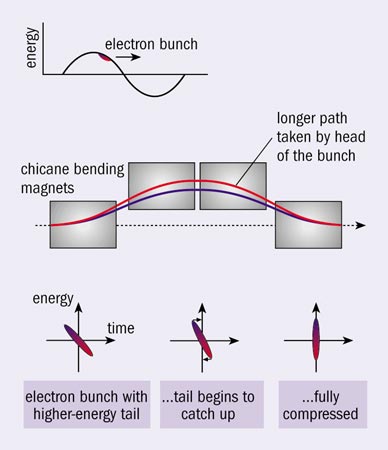
Using the full length of the linear accelerator, as well as loops and bends in the beam, and the usually troublesome effect of the wakefield, SLAC has made the world’s shortest bunches of electrons – 12 µm in length and 80 fs in time. During its first run in May, the Sub-Picosecond Pulse Source (SPPS) made high-current, ultra-short bunches of electrons and turned them into very-bright, ultra-short pulses of X-ray light. These first X-rays made by a linear accelerator are in pulses 1000 times shorter than those made by storage rings such as SPEAR at Stanford in the US, enabling direct observations of atomic motion in matter that has never been seen before.
SPPS relies on several tricks to compress the bunches, which contain 2.1 x 1010 electrons, to reach a peak current of 30 kA. The gymnastics occur in three stages, starting as the bunches leave the damping rings near the beginning of the linac. At this point a bunch travels around the curve of the ring-to-linac (RTL) beamline and is compressed from 6 mm down to 1.2 mm. In the RTL, the bunch looks like a surfer climbing a wave – the front of the bunch has more energy (i.e. it is closer to the top of the radiofrequency wave) than the back. Going through the curved path of the bending magnets, the low-energy tail takes the shortest path and catches up to the head, making the bunch shorter.
The second step in bunch compression takes place at Sector 10, one-third of the way down the linac, where the electrons have been accelerated to 9 GeV. At this point the bunches are tipped to ride slightly ahead of the wave crest, so the rear is accelerated more than the front. Entering a chicane with four bends, the higher-energy tail is able to take the shortest path and catch up again, compressing the bunch to 50 µm.
The final step in compressing the bunch is something that can only be done at SLAC. It involves picking up energy along the remaining two-thirds of the linac and using an effect previously considered a nuisance. As the electron bunches travel at the speed of light, they generate an electric wake, which is known as a wakefield. In free space the wake would spread out perpendicular to the direction of travel of the electrons, but in the beam pipe the wake made by the head of the bunch bounces off the pipe and interferes with the tail. Thus the tail has less energy than the head when a bunch reaches the end of the linac.
Fortuitously, at SLAC the bunch can be routed through the Final Focus Test Beam, where the beamline jogs right then left. This geometry forces the higher-energy front to take a longer path, and the rear catches up again. Here, the bunch has rotated upright again and is now 12 µm long. At this length the bunch of 2.1 x 1010 electrons passes a fixed point in only 80 fs. After compression the bunches are wiggled by an undulator magnet, which is on loan from Argonne National Laboratory in the US, to generate the X-rays.
The SPPS will operate over the next two years, taking data in anticipation of the Linac Coherent Light Source that will make even brighter X-rays.








